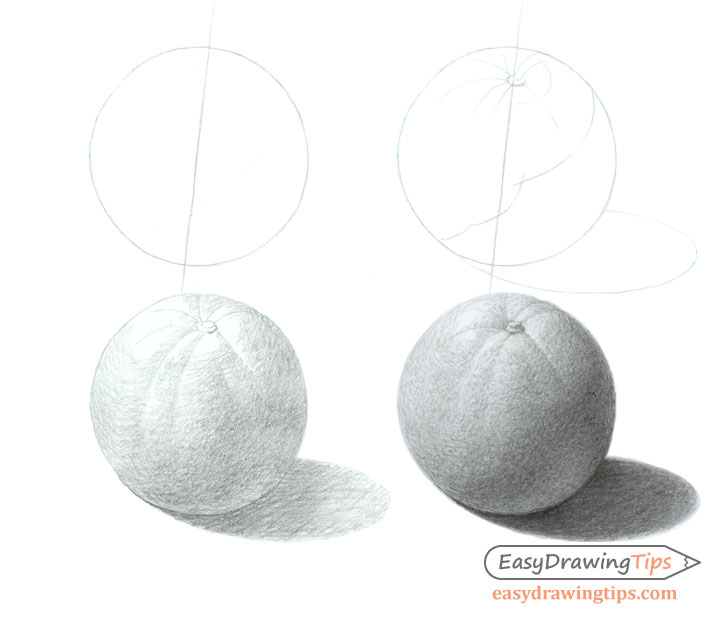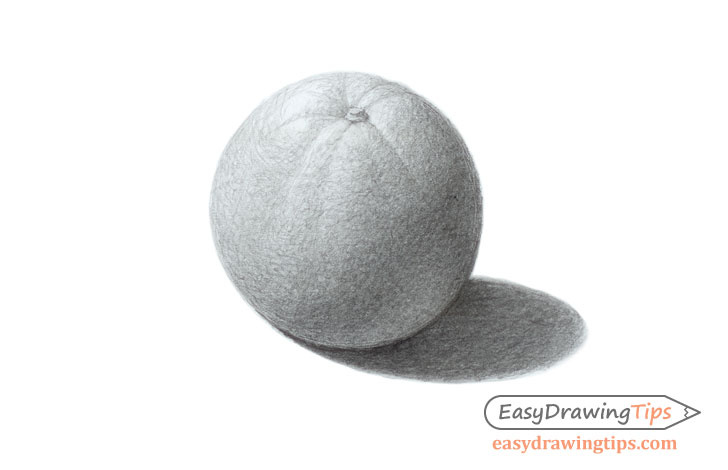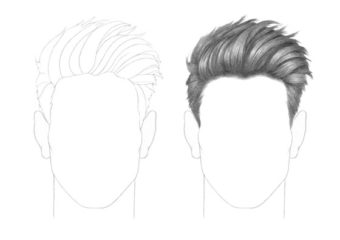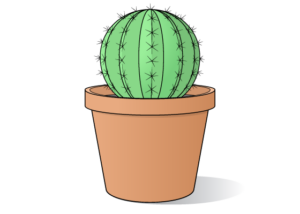How to Draw a Realistic Orange Step by Step
This step by step tutorial shows how to draw and shade a realistic looking orange and includes detailed pencil drawing examples for each step.

An orange has a fairly simple shape, basically a sphere. It does however have an interesting texture. This tutorial will focus on giving the orange a believable 3d looking shape as well as a rough texture of the skin of an orange.
Step 1 – Orange Construction Line Drawing

Start the drawing with very simple construction line sketch. As the orange in this example is slightly tilted you can draw a straight angled center line to indicate it’s tilt. Next draw it’s outer shape (basically a circle) and use the center line to help you insure that both halves are relatively equal in width.
Step 2 – Orange Line Drawing

Now add some inner details of the orange like the tip as well as the surrounding “wrinkles”.
Draw an outline of it’s shadow and optionally add some lines to indicate the split between the light and dark area. The shadow and darker area of the orange will be directly opposite of the main light source which in this case is coming from the upper left of the drawing.
Step 3 – Orange Initial Shading

Start shading the orange with a a series of fairly short crosshatch strokes and be sure to leave some space between them. Applying strokes in this way will help you create a rough looking texture that oranges usually have.
For an explanation of different stroke types see:
Shading Techniques and Stroke Types Drawing Tutorial
Darken the shaded areas by applying more layers of overlapping strokes. You can also make these strokes progressively darker until you feel you have the right balance between the light and dark areas.
Step 4 – Orange Finished Shaded Drawing

As you continue shading the orange there are a few more things to be aware of. One is that the shadow will be darker towards the base and lighter as it progresses outwards away form the orange. Another is that there will be a lighter spots on the dark side of the orange. This spot is caused by the light reflecting from the surface the orange is sitting on.
For a more detailed explanation of light and shadow when shading some basic shapes see:
Shade the “wrinkle” areas of the orange darker on the sides that are facing away from the light and lighter on the sides that face towards it.
Once the orange is almost fully shaded you can add a series of tiny dark spots (especially to the “in shadow” areas) to reinforce its bumpy texture. You can also add tiny light spots (for the same purpose) using a kneaded eraser with a pointy tip.
It may take some practice and experimenting to really get the texture so don’t give up if it does not look right the first time.
Conclusion
The overall shape of an orange is fairly simple and shading it is similar to shading a sphere. The challenge comes in trying to show its texture.
For more similar tutorials see:
- How to Draw a Realistic Lemon Step by Step
- How to Draw a Realistic Pear Tutorial
- How to Draw a Realistic Banana Tutorial
- How to Draw a Kiwi Step by Step
- How to Draw a Croissant Step by Step









